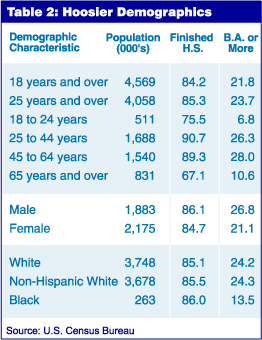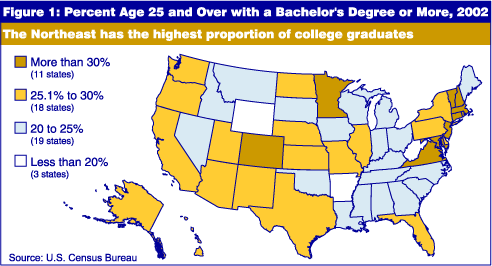Indiana Shows Marked Improvement in Adults with College Degrees
Census survey figures show significant improvement for Indiana in terms of high school graduation rates and Hoosier adults with college degrees. Between 2001 and 2002, Indiana's high school graduation rate moved up from 84.4 percent to 85.3 percent. More significantly—both statistically and as a sign of educational progress—was the 2.5 point increase in the percentage of the population with a bachelor's degree or higher. In 2001, 21.2 percent of adults had achieved at minimum a B.A. and by 2002 that percentage increased to 23.7 percent.
Indiana's rankings relative to other states and the District of Columbia have also improved (see Table 1). Click to view spreadsheet with the rankings for all 50 states and D.C.

The Gender Gap
A 13-year national deadlock between men's and women's high school graduation rates has finally been broken, based on results of the newly released report Educational Attainment in the United States: March 2001 and March 2002. U.S. women 25 and older now have a high school graduation rate of 84.4 percent, compared to the men's rate of 83.8.

Indiana continues to experience a relatively small gender gap in high school graduation rates, with 86.1 percent of men graduating high school compared to 84.7 percent of women. A larger gap persists between men and women with bachelor's degrees, with 26.8 percent of men 25 and older with a B.A. or higher compared to only 21.1 percent of Hoosier women.
Regional Gaps
According to the Census Bureau, the Northeast had the highest proportion of college graduates at 29 percent. The West followed closely behind with 28 percent, the Midwest at 26 percent, while the South had 25 percent.

About the Annual Survey
Each year, the U.S. Census Bureau conducts what is called the annual demographic supplement to the March Current Population Survey. This supplement for 2002 is notable for a significant increase in the number of households surveyed. While the Census Bureau reports no significant statistical differences because of the sample, there were some effects on the 2001 and 2002 survey data by using the Census 2000 population controls. For those readers needing detail on the sample size increase and the confidence intervals of the data shown in this article, please go to the web: www.census.gov/did/www/saipe/data/model/info/cpsasec.html.
Carol O. Rogers
Associate Director, Indiana Business Research Center,
Kelley School of Business, Indiana University
